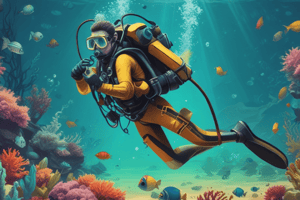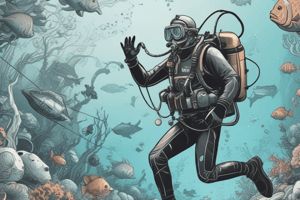Podcast
Questions and Answers
What is the most commonly used gas in scuba diving?
What is the most commonly used gas in scuba diving?
- Enriched air
- Compressed air (correct)
- Oxygen
- Nitrox
What is the purpose of a rebreather system in scuba diving?
What is the purpose of a rebreather system in scuba diving?
- To release more gas bubbles into the water
- To recycle exhaled gases (correct)
- To use more stored gas volume
- To allow for deeper and longer dives
What is technical diving?
What is technical diving?
- Diving professionally
- Diving with fins and diver propulsion vehicles
- Diving involving deeper and longer dives and greater risks (correct)
- Diving recreationally
What is the purpose of buoyancy control equipment in scuba diving?
What is the purpose of buoyancy control equipment in scuba diving?
What is the purpose of dive lights in scuba diving?
What is the purpose of dive lights in scuba diving?
What are the risks of scuba diving?
What are the risks of scuba diving?
What is the recommended depth limit for recreational diving?
What is the recommended depth limit for recreational diving?
What is the purpose of a surface marker buoy in scuba diving?
What is the purpose of a surface marker buoy in scuba diving?
What are the factors that affect the safety of scuba diving?
What are the factors that affect the safety of scuba diving?
Flashcards
Rebreather
Rebreather
A system where exhaled gas is recycled and reused, reducing gas consumption and minimizing bubbles released into the water.
Technical Diving
Technical Diving
A diving technique involving deeper and longer dives with advanced equipment and specialized breathing gases, requiring higher levels of training and experience.
Nitrox
Nitrox
An air mixture used in scuba diving that contains a higher percentage of oxygen than normal air, reducing the risk of decompression sickness and enabling longer dives at the same depth.
Buoyancy Compensator (BC)
Buoyancy Compensator (BC)
Signup and view all the flashcards
Dry Suit
Dry Suit
Signup and view all the flashcards
Decompression
Decompression
Signup and view all the flashcards
Dive Debriefing
Dive Debriefing
Signup and view all the flashcards
Buddy Diving
Buddy Diving
Signup and view all the flashcards
Scuba Gear
Scuba Gear
Signup and view all the flashcards
Study Notes
Scuba diving allows divers to breathe independently of a surface air supply, with compressed air being the most common gas used, although enriched air or nitrox is becoming increasingly popular. Closed-circuit or semi-closed circuit rebreather scuba systems allow recycling of exhaled gases, making them quieter and more efficient than open circuit systems. Scuba diving can be done recreationally or professionally, with divers using fins, diver propulsion vehicles or sleds to move underwater, and other equipment such as exposure protection, ballast weights, and signalling devices. Scuba divers are trained in the appropriate procedures and skills for their level of certification, with a minimum level of fitness and health required by most training organisations. The history of scuba diving is linked to the history of scuba equipment, with open and closed circuit systems being developed in the mid-twentieth century. Technical diving involves deeper and longer dives and greater risks of serious injury or death, and the use of different equipment configurations and breathing gases. The challenges of deeper and longer dives led to a resurgence of interest in rebreather diving in the 1990s, with semi-closed circuit and closed circuit rebreathers becoming available for the recreational scuba market. Scuba diving equipment includes the breathing apparatus, diving suit, buoyancy control and weighting systems, fins, mask, and safety equipment and accessories. Open-circuit scuba has no provision for using the breathing gas more than once, while closed-circuit systems allow recycling of exhaled gases. Most recreational scuba diving is done using a half mask and mouthpiece, while professional scuba divers are more likely to use full face masks.Overview of Scuba Diving Equipment and Techniques
-
Scuba diving involves breathing from a self-contained underwater breathing apparatus (SCUBA) to explore underwater environments.
-
The most commonly used scuba set uses a "single-hose" open circuit 2-stage demand regulator, connected to a single back-mounted high-pressure gas cylinder.
-
Rebreathers are less common but can be used to recycle exhaled breath for re-use, releasing fewer gas bubbles into the water and using less stored gas volume.
-
Gas mixtures other than normal atmospheric air can be used, such as nitrox, which is air with extra oxygen, reducing the risk of decompression sickness or allowing longer exposure to the same pressure for equal risk.
-
Personal mobility is enhanced by swimfins and optionally diver propulsion vehicles.
-
To dive safely, divers must control their rate of descent and ascent in the water and be able to maintain a constant depth in midwater.
-
Buoyancy control equipment such as diving weighting systems, diving suits, and buoyancy compensators can be used to adjust the overall buoyancy.
-
Water has a higher refractive index than air, so diving masks and helmets provide an air space in front of the diver's eyes to correct the refraction error created by the water, but objects appear approximately 34% bigger and 25% closer in water than they actually are.
-
Dive lights are useful to provide light in the darkness, to restore contrast at close range, and to restore natural color lost to absorption.
-
Protection from heat loss in cold water is usually provided by wetsuits or dry suits.
-
Diving can have risks, including decompression sickness, nitrogen narcosis, oxygen toxicity, and barotrauma.
-
Divers should receive proper training and adhere to safety procedures to minimize risks and ensure a safe diving experience.Scuba Diving Safety Procedures and Equipment
-
Scuba divers wear either a wetsuit or dry suit depending on water temperature and conditions
-
Dry suits provide better insulation and are more suitable for cold water, but are more expensive and complex to use
-
Dive computers are commonly used for monitoring depth, duration, and decompression requirements during a dive
-
Navigation during a dive can be done by landmarks, memory, compass, or guide line
-
Scuba divers carry safety equipment such as a bailout cylinder, cutting tools, and a surface marker buoy
-
Breathing from scuba is similar to surface breathing, but shallow breathing should be avoided and a slow, deep breathing pattern is recommended
-
Decompression is necessary on all scuba dives, and can be achieved through a pre-planned ascent or monitored by a personal decompression computer
-
Post-dive procedures include debriefing, equipment maintenance, and logging the dive for future reference and certification purposes
-
Buddy and team diving procedures are recommended to ensure diver safety, but solo diving is also possible with appropriate equipment and experience
-
Solo divers rely on their own redundancy of critical dive gear, including at least two independent supplies of breathing gas
-
Scuba divers may also carry underwater photographic or video equipment, or tools for specific underwater work
-
Proper attention to detail, responsibility for one's own safety, and acceptance of risk are required for safe scuba diving.Scuba Diving: Hazards, Safety, and Emergency Procedures
-
Scuba diving involves a debate about the wisdom of solo diving, with some agencies stressing the importance of diving in teams and others offering certification courses for solo diving.
-
Emergency procedures for scuba diving include managing compromised breathing gas supply, making emergency ascents, and handling medical emergencies.
-
Two types of entrapment are significant hazards for scuba divers: inability to navigate out of an enclosed space and physical entrapment that prevents the diver from leaving a location.
-
The depth range for scuba diving depends on the application and training, with entry-level divers expected to limit themselves to around 60 feet and the limit for recreational diving set at 130 feet.
-
Scuba diving is done for both personal and professional reasons, including recreational diving, underwater tourism, military diving, police diving, and scientific diving.
-
The safety of underwater diving depends on four factors: the environment, the equipment, behavior of the individual diver, and performance of the dive team.
-
Hazards of scuba diving include the aquatic environment, the use of breathing equipment in an underwater environment, exposure to a pressurized environment and pressure changes, and diving equipment failure.
-
The presence of several hazards simultaneously is common in scuba diving and can result in a cascade of incidents that overwhelm the diver.
-
Scuba divers carry their breathing gas supply with them during the dive, and the limited quantity must get them back to the surface safely.
-
The risk of dying during recreational, scientific, or commercial diving is small, but most fatalities can be attributed to human error on the part of the victim.
-
Scuba divers face special physical and health risks when they go underwater or use high-pressure breathing gas, including the risk of drowning, air embolism, and environmental hazards.
-
Divers can decrease the risks of scuba diving through proper procedures, appropriate equipment, training, and education.
Studying That Suits You
Use AI to generate personalized quizzes and flashcards to suit your learning preferences.




